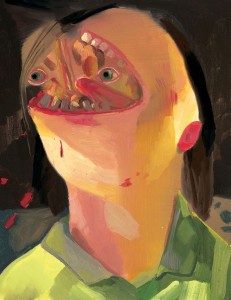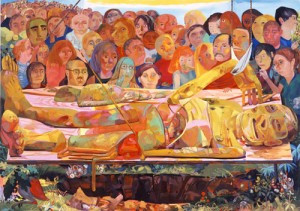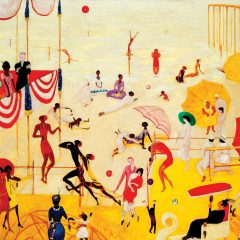Dana Schutz‘s new monograph covering works from 2001-2009 is a nice coffee table book. With 100 color plates and two short pieces of writing (taking up a scant 9 pages), the book is not a scholarly look at the artist’s work. She surely deserves that book and it will probably come, say with a big museum show. Meanwhile, for Schutz fans, this book is pure mind-bending eye candy.


Jonathan Saffron Foer‘s short introduction is a rambling shaggy dog that opines about names and naming (do you like yours? would you choose another? do you like the name of this book? how about the names of Schutz’s paintings?). He confesses he’s choosing a name for his second child so names are much on his mind. But then he gets down to it and drops some enthusiastic words about Schutz’s paintings, talking about how the works are “hugely admirable” and, he says, that’s why he wants to just get out of the way (and let the pictures speak). The most interesting point he makes is about art in general, and even though it’s not a new thought — to wit, that good art is deep but inscrutable — dropping the thought into an article about Schutz is appropriate. It’s interesting that the adamant anti-meat eating writer said not a word about Schutz’s self-eating humans.
Barry Schwabsky‘s short essay compares Schutz to Magritte in the sense that she paints self conscious paintings that wink at themselves and you (eg Ceci n’est pas une pipe, etc) — “ironic hypercongruency” is what he calls it.

Mostly Schwabsky has a lot of questions about the work that he can’t answer. What does it mean that the signers of the Declaration of Independence in the painting Signing, 2009, are depicted in cut-away, where they are seen to be made of corrugated cardboard instead of real live innards? He gets all twisted up in whether Schutz is parodying the founding fathers … or parodying a painting of the revolutionary crew.
What does it mean that Schutz’s figures are “self-eaters?” He quotes Emily Dickinson on autophagy (poem 773 in which she “entertained herself…a scant nutrition…an insufficient loaf.”) He quotes Schutz on how her paintings might be abstract because they are self-reflexive or self-involved. And finally, he is confident the works are allegorical — and that their subject is “…the problems of art’s autonomy and solipcism, so central to artistic thinking over the past six decades or more.”
Schwabsky ends with a questionable bit of evidence to link the poet of autophagy with the painter of autophagy. In Dickinson’s letters to Thomas Wentworth Higginson she defines poetry this way: “If I feel physically as if the top of my head were taken off, I know that is poetry.” And because Schutz’s paintings show people whose heads are taken off (or limbs taken off or faces taken off) the poet and the painter and inextricably linked. It still leaves all those questions unanswered, but as I say, that’s for another book.
As for the pictures, they are a generous number of them. Some are shown in close-up detail, which is nice for paintings that vary their brushstroke from cascades of abstract lozenges to flat washy watercolor-like zones to actual dead zones of black velvet holes that suggest a Heart of Darkness.

My take on the artist’s subject is simply this. The artist paints mashups of sci-fi and pop culture, all the while channeling the old masters. There are echoes of everything from Manet, Renoir and Cezanne to Leonardo Da Vinci. Singed Picnic is Manet’s Dejuner Sul Herbes; Chess is Cezanne’s card players. Mona is Mona Lisa. The Thinker is The Thinker. And I want to say Car and Driver, 2009, seems eerily heartlandish, like a Thomas Hart Benton or Grant Wood. Of course her works look like the masters have been Cuisinarted, but they don’t feel derogatory. They’re inquisitive. And they’re maybe even a little bit jealous.
Works like Presentation (above the last picture) add a layer of Grey’s Anatomy — where a figure is laid out on a work table for a moment of surgery in the public realm. We are witnesses and watchers, voyeurs just like a tv audience. For this one I also want to say Christ’s Entry into Brussels by James Ensor. And I’ll put in my literary reference here and it’s not to poetry. Cormac McCarthy’s “The Road” . We’re on a journey with Schutz in the driver’s seat, and the sites she’s showing us are pure post-apocalypse.
More images of Dana Schutz’s work at Saatchi Gallery online and Zach Feuer Gallery.
Dana Schutz
Text by Barry Schwabsky, Foreword by Jonathan Safran Foer
Pub Date: April 2010
Format: Hardcover
Category: Art – Individual Artist
US Price: $45.00
CAN Price: $55.00
ISBN: 978-0-8478-3329-0 (0-8478-3329-1)
Publisher: Rizzoli









